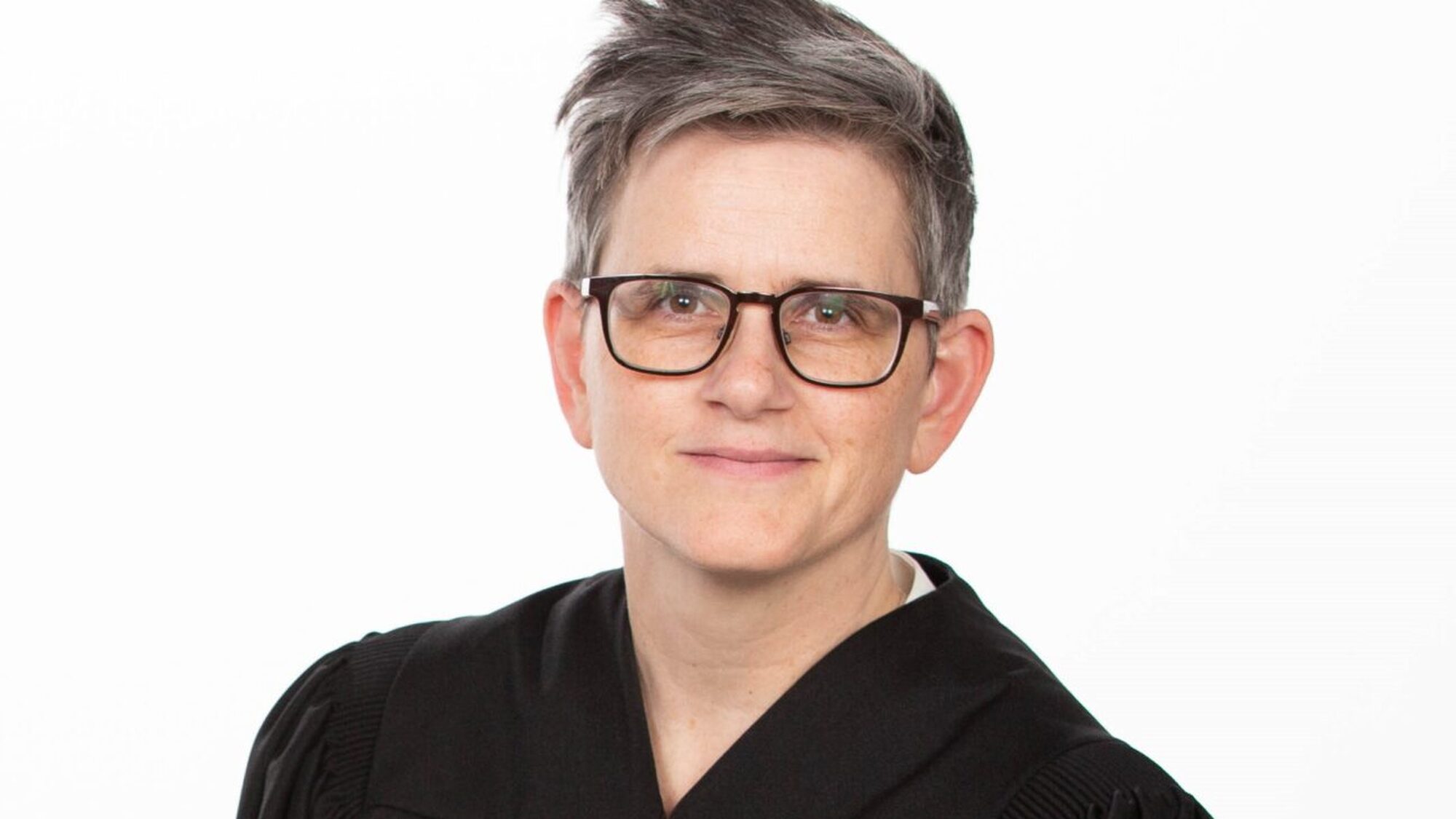Matt Alsdorf, associate director of the Center for Effective Public Policy, conducted the interviews from May through August 2024. The interviews are edited and condensed.
Matt Alsdorf: How is implementation of the Pretrial Fairness Act going for your county overall?
Elisabeth R. Pollock, Chief Public Defender, Champaign County: Implementation in terms of court procedures has been incredibly smooth. We put together a task force before the law was supposed to go into effect in January 2023 [a]. Our judges and us created agreed-upon forms for conditions of release, court procedures for detention hearings, and the schedule for hearings. So we were prepared for the change in the law. And we’re adapting as new decisions come from the 5th District Appellate Court.
We have monthly meetings with the sheriff, corrections, court, state’s attorney, Office of Statewide Pretrial Services, and probation. We try to do crash courses on what changes need to happen, or if there’s updates, like where are we at on transport officers and vehicles? Where are we at on updates from the appellate court? We’re covering it all in those meetings.
Jeff York, Chief Public Defender, DuPage County: It’s going rather well. We had some hiccups in terms of process, but nothing major. We worked very well with the state’s attorney, probation, court, and sheriff’s office, so all the players were ready to do the work to implement it well.
The most difficult thing is knowing which facts of a case are likely to result in a person’s potential detention. There are times we’ve lost an argument at a detention hearing that surprised us. There are arguments that we won where we were surprised. As time goes on, getting more clarification of which types of things are detainable will help.
Matthew Vaughn, Chief Public Defender, Jefferson County: I thought there would be more violations of my clients who are granted pretrial release, especially people with addictions and those who engage in what I would call serial retail theft on a felony basis. Has that happened? Yes. Has it happened as much as I thought it would? No, it hasn’t.
The other thing that surprised me, and perhaps if I thought it out further, it should not serve as a surprise: In the past, it was common for some of my clients charged with very serious offenses to post a bond of $5,000, $6,000, $7,000, $8,000. That’s not on the table now. What I’ve experienced is that money that would ordinarily go to bond is now often going to hire private attorneys.

Alsdorf: What are the most positive changes you’ve seen since the Pretrial Fairness Act went into effect?
Elimination of Money Bond
The Pretrial Fairness Act completely eliminated money bond as a condition of pretrial release for people entering the criminal legal system.
Pollock: Cash bond is discriminatory. I came from the federal system [b], so I’m very used to the detention hearing process and consideration of detention based on a person’s risk to community safety and risk of flight. That’s the correct way to do things, and the data supports it.
We know what happens to people when they’re detained pretrial in terms of employment, housing, and everything else. We shouldn’t be extorting the poorest people among us to post bond. The spirit of the law is absolutely on point. We’ve seen across the state, in terms of the counties where maybe they weren’t being so judicious with their cash bond amounts, those jail populations have decreased significantly. So, overall, I would say I agree with the law. It has made an impact across the state. I’m a huge fan.
Defense Counsel Receives More Information Before Hearings
Under the Pretrial Fairness Act, defense counsel now receives evidence the prosecution plans to use in advance of first appearance hearings.
York: We, public defenders, are actually being lawyers. Before, we really weren’t given an opportunity to argue much: we’ve had very brief access to our clients just in the last few years and, before that, we didn’t even have that. Prior to the Pretrial Fairness Act, you’d make something up in terms of an argument. Now, we actually have information. That’s a huge positive. The hearings are more meaningful and substantive.
However, the way the Pretrial Fairness Act is structured, prosecutors only have to give us the information they tend to rely on or that they will rely on in the hearing. I can see that being a sticking point going forward where we aren’t getting objective information to actually properly represent people because the state doesn’t want us having it because it helps us too much.
Rachel Wydra, Assistant Public Defender, DuPage County: The domestic violence supplemental report is so helpful. The report includes prior alleged incidents between the parties. Are there kids in the home? Are there firearms? What used to happen is the state would come into the bond hearing and they would read things from the domestic violence supplemental report and leave out everything helpful to the defense. Now, we get those reports, so we can use that. We also get more time with clients to talk to them about the case. And then we get the risk assessment reports from pretrial that they generate, which goes through their background, their job, their kids, other important information. Before the Pretrial Fairness Act went into effect, you would try to get information really quickly over the phone before a bond hearing. Now, there’s just a little more time to dig into those cases.
Vaughn: I questioned whether pretrial services would be able to get us the criminal histories and background information of the person charged in time to have a meaningful detention hearing. I thought they would struggle to do that. They have not. The reports we get are pretty good in terms of criminal history. But verification that the person works, other than their word, is not happening. My guess is they don’t have time to verify with employers, or employers are not cooperating because they’re embarrassed that one of their employees was arrested.
Increased Pretrial Release
The Pretrial Fairness Act requires the release of people arrested on offenses not eligible for detention (725 ILCS 5/109-1). For detention-eligible offenses, detention is ordered only after a prosecutor-requested hearing with evidence presented by both sides. Research supports reducing unnecessary detention pretrial because there is a significant relationship between a few days of pretrial detention (i.e., 1, 3, 5, or 7 days) and worse pretrial outcomes, including an increased likelihood of a new arrest in the future.
York: More people definitely get an opportunity to be in the community, and that’s a positive. The only problem is when they violate conditions of release, they’re getting sanctioned or revoked on a pretty regular basis in our county. So the benefit of being in the community can be fleeting for some people. But I think it has been a positive overall. Under the old law, they certainly would have been waiting to post bond in many cases, even if it was for a few days. So you’re minimizing the time in custody for the people who are getting released.
Wydra: It’s nice not to have misdemeanor clients sitting in jail because they can’t post $300 on a criminal trespass case. And I think people charged with possession of controlled substances are getting out without having to post money because those bonds tended to be higher back in the day. That is the biggest positive of the new law.
Vaughn: I anticipated that it would be common for the State’s Attorney’s Office to announce a decision whether to detain or not a few minutes before the hearing. That really hasn’t happened. The state’s attorney’s office in this county, for the most part, is making a quick decision whether to detain or not.
Alsdorf: How is the new detention process going overall?
Wydra: The detention hearings take a lot longer than old bond court. It’s much more involved, which I personally like. I think that tends to be beneficial for our clients. It used to be you walk into bond court, you’ve talked to your client, but you don’t have any discovery or information on the case. So for me, that’s been really helpful to have more background on the case and the client.
Pollock: I’m not seeing a lot of detentions in cases where I would not expect to. The state is filing them probably not as aggressively as in some other counties, as I’ve heard from colleagues.
We’re mostly seeing petitions for detention in cases like robbery or burglary if there’s an element of violence or they’ve got multiple prior burglaries and they think they’re not going to stop. Murder, guns, stuff like that is where we’re seeing those detention petitions.
We’re prepping harder for detention hearings than we had to for bond arguments. The bond arguments before the Pretrial Fairness Act were pretty rote like, What can you afford? What can’t you afford? Now, we are delving more into the factual basis of each allegation. It’s not just “How much money do you have and where do you live?”
Anytime you’re able to advocate more fully, it’s better for the client. And the more information that gets in front of the judge, the better. The quality of those hearings has increased substantially.
Vaughn: What caught me off guard was that I expected detention hearings, in terms of prep time, to take about as long as the run-of-the-mill bond reduction hearing in felony court in the past. I was wrong for thinking that. They take longer. There’s more prep work involved in gathering the information you need to be ready for a detention hearing. The hearings in court take longer than a bond reduction hearing on a typical felony case prior to September 18, 2023, the date the Pretrial Fairness Act went into effect. I think the clients are getting a fair hearing.
Alsdorf: I understand that domestic violence offenses are driving detention numbers in many jurisdictions. What are your observations about that?
Felony and misdemeanor domestic violence and violations of orders of protection offenses are eligible for detention under the Pretrial Fairness Act (725 ILCS 5/110-6.1).
York: From a defense attorney perspective, I was horrified that misdemeanors were included in the Pretrial Fairness Act because they’re misdemeanors. If you want to make them felonies, make them felonies. If you don’t, then what are we doing?
The biggest struggle with my clients are these in-between cases, domestic violence and lower-level felonies, where previously they might have been able to post a money bond and get the funds together, and now they’re held with no bond. That’s the biggest negative of the new system.
I understand domestic violence is a tricky area. But that is by far the number one offense where we’re having either contested issues or hearings. And that’s the biggest driver of the numbers of detention hearings and people detained.
Pollock: We have a much larger percentage of people in custody who are charged with domestic violence, and that includes misdemeanors. Under the old cash bond system, unless it was really egregious, a strangulation Class 2 extended term type of charge, we were getting release on recognizance [c] on most of those cases, or maybe a minimal bond amount. The standard of law is that unless you can show that there are no other conditions available, you shouldn’t be detaining these people. For people who don’t have a record, a history of violations, or a history of violating no-contact orders, it seems insane that the court is detaining them, saying that there is no other combination of conditions available. There certainly is. We’ve got GPS devices [d] available right now. You can put a bracelet on somebody, and if they violate an exclusion zone, our Office of Statewide Pretrial Services is going to be automatically notified. But our judges have been detaining people at a higher rate in those types of cases than I would have ever expected.
Alsdorf: What has been challenging about transitioning to the Pretrial Fairness Act?
Swift Case Processing
Section 110-6.1(c)2 of the Pretrial Fairness Act outlines requirements to make pretrial release decisions swiftly.
Vaughn: The one prediction that I made—which was an ongoing problem—is we have great, great difficulty in meeting the time frames under the statute for detention hearings. The statute in Illinois does contemplate affording defense counsel the opportunity to delay these things to gather more information. We’ve had to do that some of the time but, typically, we need an extra day because the attorney who’s assigned to do this has other court commitments, is getting prepared for trial, and often cannot meet with that client and be prepared for the detention hearing in the time frame called for under the statute.
Pollock: There are different issues that have not been formally resolved by the Illinois Supreme Court. Our county has interpreted the statute to not include weekends for calculating the requirement to hold hearings within 24 or 48 hours. If somebody is arrested on a Friday, their first appearance will be on a Monday. That has not been done in other counties that construe the 24- or 48-hour requirement to include weekends and holidays.
On our Monday arraignment court list, there are so many people that they’re not going to be detained because it’s a nondetainable offense. But because we don’t have court on Saturday and Sunday, they’re stuck in jail over the weekend, which kind of defeats the purpose of the Pretrial Fairness Act, which is recognizing that even detention for a day or two can really ruin your life. And the whole point is, if you’re not detainable, you shouldn’t be able to be held.
Remote vs. in-person hearings
725 ILCS 5/106D-1 of the Pretrial Fairness Act limits first appearance hearings by video to only those situations where a local court has cited health and safety risks or operational challenges to holding in-person first appearance hearings. Courts are required to make efforts to address the operational challenges.
Pollock: We have not been able to have in-person detention hearings [e] because we don’t have enough correctional staff, and our jail is about a mile and a half from the courthouse. To transport people to court for in-person detention hearings, we need many, many more correctional officers. Our chief judge has taken the Illinois Supreme Court up on its invitation to continue remote appearances.
That will end at some point. We’re trying to develop a plan for how we will handle in-person appearances. But I’m not a fan of remote appearances. You don’t get the kind of communication with your client. You should be able to lean over and have a conversation with your client during a hearing like this.
Resources
Public defenders experienced a dramatic increase in their workload with the new pretrial release and detention hearings. Although the state legislature appropriated additional funds for public defenders in 2023, there is no guarantee the money will be renewed to provide sustained funding. A bill has been introduced in the state legislature, the Funded Advocacy and Independent Representation (FAIR) Act, to, among other things, maintain funding for public defenders and create a statewide office of public defense.
Pollock: Our intake has doubled in terms of time commitment. We now have two people, sometimes three, assigned to intake every morning because we’ll have to talk to and represent up to 20 people. We’re not just talking to them about bond arguments or what their charges are. Now, we’re talking to them about the possibility of a detention petition, how that would play out, what their appellate rights are, and how to proceed with that.
I am not a huge fan of what the new process has done to my staff. We are overwhelmed and frustrated. We’ve got three of 15 attorneys in court every single day not working on their own cases. It’s been difficult to maintain the pace and volume, and that’s my biggest complaint.
York: It’s absolutely put a strain on our office. I’m lucky that I have a county board that’s been responsive. Under the old law, we didn’t need any designated lawyers; we just took turns. I’ve added five additional full-time staff. We needed five to help cover weekends. I literally had to pull them out of courtrooms, court assignments.
It’s been a strain, and we’ve managed, but we’re still not even close to where we were prior to the Pretrial Fairness Act being implemented because we haven’t been able to fill those spots to reduce the caseloads of the attorneys in trial courtrooms.
Vaughn: There has been some funding provided by the Administrative Office of the Illinois Courts, but the problem I have, and this is a problem throughout the state, is finding somebody to hire to do the work. I’ve got money but I can’t find folks who want to come to Southern Illinois and be lawyers. That’s the bottom line.
Ambiguity in the new law
York: There were some specific things that people didn’t think of when they drafted the Pretrial Fairness Act legislation, and now it’s left to interpretation, and the results are inconsistent.
For example, the use of sanctions is a little troubling. If someone violates their conditions of pretrial release, even sometimes on things that we wouldn’t think were a huge deal, depending on the judge, they’re getting 30 days in jail. And some judges also say those 30 days don’t get applied to your sentence on the case on the back end. We have judges all over the map on that. In one courtroom, they’re getting day for day on a sanction, and next door, they’re not.
There are other aspects, like what happens to people in specialty court. That’s been a real issue in our jurisdiction. The specialty court judges say that the Pretrial Fairness Act doesn’t apply to specialty courts. We say, of course it does.
Appeals
To limit the dramatic increase in appeals filed since the Pretrial Fairness Act was implemented on September 18, 2023, the Illinois Supreme Court adopted several new rules in April 2024. These include requiring defense attorneys to file a “motion for relief” before the trial court, creating additional responsibilities for trial attorneys, and allowing an appeal only after the trial court has ruled on that motion. People who have been accused may have only one pretrial release appeal at a time, and they cannot be advised of their right to appeal until after a motion for release has been heard.
Vaughn: I am frustrated at the modifications to Illinois Supreme Court rules about how to handle Pretrial Fairness Act appeals. I thought that was the judicial branch basically pushing the problem created by statute downward. The rules basically say, “You folks at the trial courts, you need to exercise your discretion before you file an appeal and before you process the motion and reconsider.” They had the same problem we did, and that’s a lack of staffing to handle all the appeals.
Pollock: The automatic appeal of right has been incredibly problematic because it’s another round of conversations we need to have with each client after every decision. And it’s not just if you’re detained. You can appeal the conditions of release. If you don’t want the GPS monitor the court requires, we have to file a motion for relief. It’s just ridiculously burdensome.
Alsdorf: How are judges and the state’s attorney’s office using their discretion in determining conditions of release and detention?
Vaughn: The best way I can describe that is initially, after September 18, 2023 [f], there was not a lot of discretion being used by the state’s attorney’s office. It was an attitude of when in doubt, we’re gonna try to detain. It took some adverse rulings to get that straightened out. But within a couple months, I noticed that the state’s attorney’s office was being far more selective in terms of which cases to file a petition to detain.
It took a while for the judges to become comfortable with exercising their discretion in denying petitions for detention. In the last three months, they have exercised their discretion way more than they did in October, November, and December of 2023, in my opinion.
Guns is the recurring theme among felony cases detained. We are awash in firearms here. It’s a gun culture here. Aside from sex cases and, of course, murder cases, those are the folks who are getting detained in criminal felony court.
Pollock: We win a fair number of detention hearings, so our judges are doing a pretty good job of not just stamping the State’s motion to seek detention. I don’t agree that the state’s attorney is doing a good job of utilizing their discretion on what to file because they file a lot. If somebody has a failure to appear or missed a court date and had to do a motion to quash, the state’s attorney’s office is arguing that it’s evidence of local flight. Well, that’s not the definition of willful flight [g] in the statute.
In any case with a firearm, they’re moving to detain for the most part, and this includes people who have no criminal convictions, but they’re charged with an aggravated unlawful use of a weapon because they had an uncased weapon in their car. I think that is a political response to gun violence in our community, and they feel that guns have caused so many problems in Champaign County. I feel the state is overfiling. I’m also sure that they’re not filing as much as the smaller counties are, so they do exercise their discretion to a certain degree.
The one thing I have noticed is that when it comes to trying to revoke pretrial release, usually the state’s attorney files a petition if somebody commits a new offense while on pretrial release. I haven’t seen petitions to revoke release for any other allowable reason, like if somebody tests positive for a substance or if they miss a court date. They’re not trying to revoke people for that.
Alsdorf: Are there changes you would want to make to the Pretrial Fairness Act?
Pollock: Legislators did a pretty decent job at listing the specific offenses that are detainable. There’s a few minor tweaks I would make. But, overall, prosecutors and judges are always going to need discretion because every case is different. They have to be able to look at individual fact patterns.
I wish that the list of detainable offenses was shorter and that we, as a community, could decide that somebody who’s arrested on their first domestic violence charge shouldn’t be subject to detention because they haven’t been proven to violate those court orders. I wish that nondetainable also meant nonarrestable, so you can’t leave somebody in the jail if it’s a holiday weekend.
This is going to be a battle in the Legislature. Prosecutors are going to push to add more detainable offenses to the list, and we’re going to push for less. In that sense, I don’t feel like we need to change the list in any significant way, except to say that maybe as a value judgment for these very small groups of offenses.
Alsdorf: Are you collecting data about, or do you have a sense of, how the Pretrial Fairness Act affected your pretrial system?
Vaughn: The numbers of people in pretrial detention are down. There’s no doubt about it. I see it on the inmate list sheet I receive every day. I would say there are about a third to a half fewer folks in jail.
Before, I had so many clients who are charged with armed violence or armed habitual criminal, who would post a $7,000 bond and be out of jail. Those folks are being detained now, and they’re hiring private lawyers with that money that would otherwise go to bond.
The folks being detained are charged with sexual assault, child pornography, guns.
Pollock: The jail population is down, but it’s not the stark reduction seen in some other counties. Champaign County is, I think, kind of an outlier. Before the law went into effect, I looked at everybody in our jail pretrial. We did not have a lot of low- to mid-range cash bonds. Everybody who was in was in on a substantial cash bond. Of the 300 people detained, I found about 25 people whose charges would not be detainable under the Pretrial Fairness Act. Everybody else was presumptively detainable.
Overall, we have seen a very, very gradual reduction in the pretrial detainee population. I attribute the decrease in our local jail population not to the Pretrial Fairness Act but to the fact that the public defender’s office is now fully staffed. Now, the jail population fluctuates between 215 and 230.
York: Just recently, the 18th Judicial Circuit Court Clerk did a public dashboard, so you can get a lot of the statistics.
When we presented to the county board together a month or so ago [h], the state’s attorney emphasized that the failure to appear rate for felonies was higher: 15 percent. I pointed out that the failure to appear rate overall—all case categories, misdemeanors, domestic violence, felonies—is virtually the same. Before the Pretrial Fairness Act, it was 10.42 percent. After the Pretrial Fairness Act, it was 10.41 percent.
And it’s a different set of people in there. I think there’s more people with domestic violence charges that are probably in custody than there used to be. And there are fewer people charged with things like possession, retail theft, and things like that.
Find more information on the CEPP’s Illinois Pretrial Fairness Act Resources.





